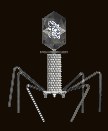 In 1919, long before antibiotics were commonplace and long before the notion of drug resistance had emerged, a doctor in the east European state of what is now Georgia, Felix d’Herelle, gave a patient suffering from severe dysentery a seemingly lethal concoction of viruses. You might think such a drink would kill the patient, but these were no ordinary viruses, they were bacteriophages, the nemesis of bacteria.
In 1919, long before antibiotics were commonplace and long before the notion of drug resistance had emerged, a doctor in the east European state of what is now Georgia, Felix d’Herelle, gave a patient suffering from severe dysentery a seemingly lethal concoction of viruses. You might think such a drink would kill the patient, but these were no ordinary viruses, they were bacteriophages, the nemesis of bacteria.
The patient was well again within a week.
Thus was heralded in the age of phage therapy. Different viral strains were selected for almost every bacterial infection. Diseases were cured. What’s more, because bacteriophages are themselves in some sense alive, they can evolve to keep up with any resistance efforts mounted by the bacteria.
So what happened to bacteriophages? Why are the news headlines filled with stories of new deadly bacteria, such as MRSA, and the newly re-emerged forms of tuberculosis? Why are we so worried about outbreaks of E coli, salmonella, and other bacteria. Surely, we have a whole armoury of trusty phages to turn to that can wipe out the rank and file of resistance microbes quickly?
Well, we don’t, somewhere between the discovery of penicillin and the second world war, chemical antibiotics fell in to pharmaceutical line as the treatment of choice to deal with bacterial infections. Never mind the fact that within months of the first dose of penicillin being given doctors were already seeing resistance. Today, there are thousands of antibiotics on the market, some are even available over-the-counter in southern Europe. Moreover, in countries that cannot really afford to use them, individuals receive short dose regimens that don’t cure their illness and provide new opportunities for bacteria to develop resistant genes.
Swiss science editor Thomas Häusler tells the story of bacteriophages and phage therapy from its humble roots to its dimly recalled heyday of the 1920s and 1930s in his book Viruses vs. Superbugs. He tells a tale of rancidity and disease that were all but eradicated by bacteriophages but that is gradually returning as hospital wards succumb to the resistant hoards and various sectors of society, such as drug users and the homeless are dealt a deadly blow as TB and other “old” diseases crawl the streets.
In the USA alone some 90000 people die each year from these so-called superbugs. The likes of the World Health Organization and other official bodies agree that things can only get worse. Perhaps a discovery from the middle of the Great War of 1914-1918 could take the place of the dozens of obsolete antibiotics stacked on pharmacy shelves and provide a final cure for the bacterial infections that until the 1960s the medical profession had all but consigned to the history books.
 It’s Boxing Day and you’re probably seriously bored playing the “normal” game of Pick-up Monkeys. Rather than heading for the Wii or the PS3, how about adding a little monkey magic, or more seriously some wire binders and following Dr N. Michael Green, Division of Mathematical Biology, of the UK’s prestigious Medical Research Council (MRC) National Institute for Medical Research to do a little bit of science education with those colourful plastic monkeys.
It’s Boxing Day and you’re probably seriously bored playing the “normal” game of Pick-up Monkeys. Rather than heading for the Wii or the PS3, how about adding a little monkey magic, or more seriously some wire binders and following Dr N. Michael Green, Division of Mathematical Biology, of the UK’s prestigious Medical Research Council (MRC) National Institute for Medical Research to do a little bit of science education with those colourful plastic monkeys. Our sense of smell is much better than we give it credit for. A report in Nature Neuroscience puts paid to the notion that the human reputation for having a poor sense of smell compared to other animals.
Our sense of smell is much better than we give it credit for. A report in Nature Neuroscience puts paid to the notion that the human reputation for having a poor sense of smell compared to other animals.